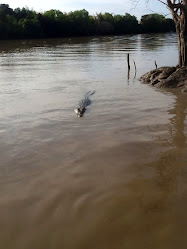yes that is raw pork in his hand
Pat (tour guide) is a native of the northern territories - he grew up in a family of 28 because his parents fostered children including a number of aboriginals. He is a bush man that feels more at home with nature than with people (although you would never know this as he is quite the talker and full of interesting stories). He has lived a great part of his life living in the bush and sleeping on the ground - he told us the first time he went to a hotel he couldn't get to sleep in the bed so he tried the floor and then finally got to sleep on the outside balcony. He was a wealth of knowledge including telling us about the soldiers in WWII defending this region and surviving the living conditions in extreme natural elements.
The day started by being picked up at 7am. First stop was the termite mounds - some of these mounds are 6 meters high with another 12 meters of the mound underground. Termites feed on dead plant material mostly wood. Therefore most of the trees in the northern territories are hollow and the aborginies use the hollow trees to make the didgeridoo musical instrument. There are 23 species of termites in this area (we observed the catherdral and magnetic termites). Termites live about 30 years in very organized colonies generally with a population of several hundred thousand divided into groups (workers and soldiers).
The sculptured termite mounds sometimes have elaborate and distinctive forms - tall wedge-shaped mounds with the long axis oriented approximately north–south. This orientation has been experimentally shown to assist thermoregulation. The column of hot air rising in the aboveground mounds helps drive air circulation currents inside the subterranean network. The structure of these mounds can be quite complex.
Next we went to the Litchfield National Park to take a look at a couple of spectacular waterfalls with sink holes where we took a swim. These fresh water bodies can be home to fresh water crocodiles which are apparently quite harmless to humans - luckily we did not see any and did not have to test this theory! While we were enjoying a swim Pat prepared a lovely picnic buffet sandwich spread for our lunch.
Pat also explained about the controlled burning practices in the northern territories. The frequency and severity of the fires in grass and open bushland areas can be reduced by carrying out controlled burning earlier in the dry season, when there is less fuel on the ground. Driving through the park we observed areas where burning had been undertaken in the last few days.
Next we were off to the river to find salt water crocodiles. These are the ones that are likely to eat you - Pat has been bitten by a croc. Crocodiles do not have diseases they are extremely healthy and do not get sick. If they loose a leg or arm in a fight their blood automatically clots so they do not bleed to death and they do not get infections. Scientist are looking at crocodiles to help develop a new type of penicillin. These crocodiles are between 4-7 meters long. Crocodiles have strong jaws and do not chew their food but swallow in large chunks which are broken down in the stomach. It is estimated that crocodiles live for 70 - 100 years. Once on the river it was not long before a crocodile was following the boat. Crocodile Pat began to feed the croc - at one point there were six crocs near us and we interacted (well crocodile Pat did) with three. I took the photos below as well as capturing a couple of videos I hope you will enjoy and get a feel for what it was like looking at these creatures so closely.
We spotted a baby crocodile which is unusual but I was not quick enough to get a picture. However I was able to get pictures of other wildlife such as jaberoos (species of water bird) and hawks.

On the tour I met three sisters from tasmania (Kerry, Jenni and Robin). We seemed to instantly bond and it was great to share the day with them.

























Well done on posting videos... Love croc dundees voice!!! I could only watch two videos they said others were private!!!
ReplyDeleteFantastic pics- cannot believe how close those crocs came!